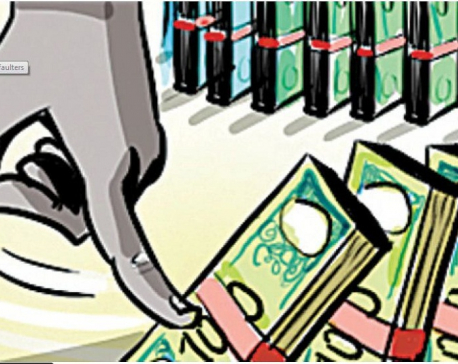
OR
Lending slows as banks focus on recovery of loans at fiscal year-end
Published On: July 5, 2018 07:55 AM NPT By: Republica | @RepublicaNepal
KATHMANDU, July 5: Commercial banks have slowed down their loan investment as they prepare to close their accounts at the end of the current fiscal year. Deposit flow in the banking system, however, has increased amid rise in government spending.
Data compiled by Nepal Bankers Association (NBA) shows that 28 commercial banks extended Rs 17 billion in the past three weeks (between June 8 and June 29), while their deposit rose Rs 41 billion
in the same period. With this, total outstanding deposit and loans of these commercial banks has reached Rs 2,377 billion and Rs 2,080 billion as of as of June 29.
The recovery in deposit mobilization by commercial banks, who have been suffering from the shortage of lendable fund since long, comes in the wake of the rise in government expenditure at fiscal year-end. Increased government spending pumps more cash into the banking system.
According to the data of Financial Comptroller General Office, the government has so far spent 54.26 percent of the capital budget allocated for the current fiscal year. The government has spent Rs 181.88 billion out of Rs 335.18 billion allocated for development spending for FY2017/18. A lion's share of such fund was spent in the past two months.
Despite deposits growth, bank lending has slowed in recent days. Bankers say that the slowdown in lending at the fiscal year-end is a natural phenomenon in the banking industry. “Since most of the banks focus on recovery of their loans in the last month of the fiscal year, lending slows down during this time,” Bhuvan Dahal, CEO of Sanima Bank Ltd, said.
According to bankers, many investors also do not seek loans during this time when business firms close their book and accounts.
Banking industry has been seeing shortage of lendable fund in recent months due to mismatch in their deposits and loan growth. As banks expanded their lending investment sharply despite slow growth in deposit, the credit to core capital cum deposit (CCD) ratio of many banks have reached a saturation level.
Nepal Rastra Bank (NRB) requires banks to maintain CCD ratio of 80 percent. Many banks even saw their CCD ratio touching the upper limit, leading to a sharp rise in deposit rates. However, even the increment in deposit rates to over 13 percent failed to bring adequate deposits into the banking system. The skyrocketing interest rates prompted bankers to cap their saving rate at 7 percent and fixed deposit at 12 percent.
You May Like This

Commercial banks unlikely to reach all local units by fiscal year-end
POKHARA, May 10: The government's plan of taking commercial banks to all local units is unlikely to materialize in the current... Read More...

Non-performing loans of banks decline despite surge in lending rates
KATHMANDU, Nov 29: Non-performing loans (NPL) of commercial banks slightly increased in the first quarter of the current fiscal year 2017/18... Read More...

Commercial banks lending aggressively despite facing liquidity crunch
KATHMANDU, Sept 28: The commercial banks in the country issued loans to their clients almost four times the deposit collection last... Read More...





Just In
- MoHP cautions docs working in govt hospitals not to work in private ones
- Over 400,000 tourists visited Mustang by road last year
- 19 hydropower projects to be showcased at investment summit
- Global oil and gold prices surge as Israel retaliates against Iran
- Sajha Yatayat cancels CEO appointment process for lack of candidates
- Govt padlocks Nepal Scouts’ property illegally occupied by NC lawmaker Deepak Khadka
- FWEAN meets with President Paudel to solicit support for women entrepreneurship
- Koshi provincial assembly passes resolution motion calling for special session by majority votes






_20220508065243.jpg)






Leave A Comment